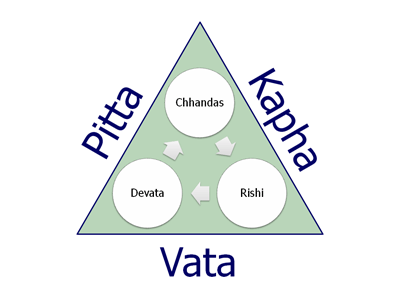The Subdoshas
The Subdivisions of Vata - Pitta - Kapha

We've seen that the Three Doshas are the abstract building blocks from which manifest creation arises. Vata represents movement. Pitta represents metabolism and transformation. Kapha represents structure. In executing their functions in the physiology, each of these has five divisions. They are known as the Subdoshas because they can be felt in the radial pulse just below the surface level.
| Division | Functions | Common Signs of Disturbance |
|---|---|---|
| Prana | Respiratory & nervous systems, inspiration | Anxiety, insomnia, monkey mind, asthma |
| Udana | Upward force, expiration | Acid reflux, stuttering |
| Samana | Movement of Agni | Impaired digestion |
| Apana | Downward force | Constipation, menstrual or genito-urinary problems |
| Vyana | Circulation of blood and nerve impulses | Raynaud's, hypertension, arrhythmia, tremor, panic |
| Division | Functions | Common Signs of Disturbance |
|---|---|---|
| Pachaka | Initial digestion of food | Hyperacidity; weak digestion with Ama |
| Ranjaka | Conversion of Rasa to Rakta | Liver disorders, anemia |
| Sadhaka | Digestion of experience & fulfillment of desires | Heartbreak, anger, heart disease |
| Alochaka | Inner and outer vision | Eye problems |
| Bharajaka | Skin health | Rashes |
| Division | Functions | Common Signs of Disturbance |
|---|---|---|
| Kledaka | Stomach lubrication | Indigestion |
| Avalambaka | Supports heart and low back | Heart, lung or spine disorders |
| Bodhaka | Lubrication of mouth and throat | Hoarse voice |
| Tarpaka | Lubrication of brain & spinal cord | Brain fog, headache, sinus congestion, greed |
| Shlesaka | Lubrication of joints | Arthritis, edema |
Disturbance of the Subdoshas occurs when surface imbalance penetrates deeper into the physiology and begins to localize. Further progression into the tissues (Dhatus) will set the stage for disease. Here as elsewhere, "An ounce of prevention is worth a pound of cure." Ayurvedic guidelines for a health-promoting daily routine, healthful eating habits, life supporting behaviors, and seasonal detoxification can make a big difference. It also helps to deal with the specific factors that may have caused the imbalance.
Resources
- Ayurveda Consultation Process
- Ayurvedic Vegetarian Cooking Classes
- Guided Grocery Shopping
- Group Lectures on Ayurveda
- Food and Health
- The Doshas
- The Three Gunas
- Vedic Science
- The Dhatus
- Ideal Daily Routine
- Managing Personal Change
- Balancing the Doshas
- Managing Indigestion
- Ama Reduction
- Home Detoxification
- Rasayanas - Elixirs for Health
- New Client Questionnaire
- Health Habits Assessment
- Ama Assessment
- Digestion Assessment
- Dosha Imbalance Assessment
- Dosha Assessment
| Prakriti | Kapha | Pitta | Vata |
|---|---|---|---|
| Vata | V | V | V |
| Pitta | P | P | B |
| Kapha | K | K | B |
| Vata-Pitta | V | P | V |
| Vata-Kapha | K | V | V |
| Pitta-Kapha | K | P | B |
| Tridosha | K | P | V |
V = Vata Pacifying Diet
P = Pitta Pacifying Diet
K = Kapha Pacifying Diet
B = Balanced Diet